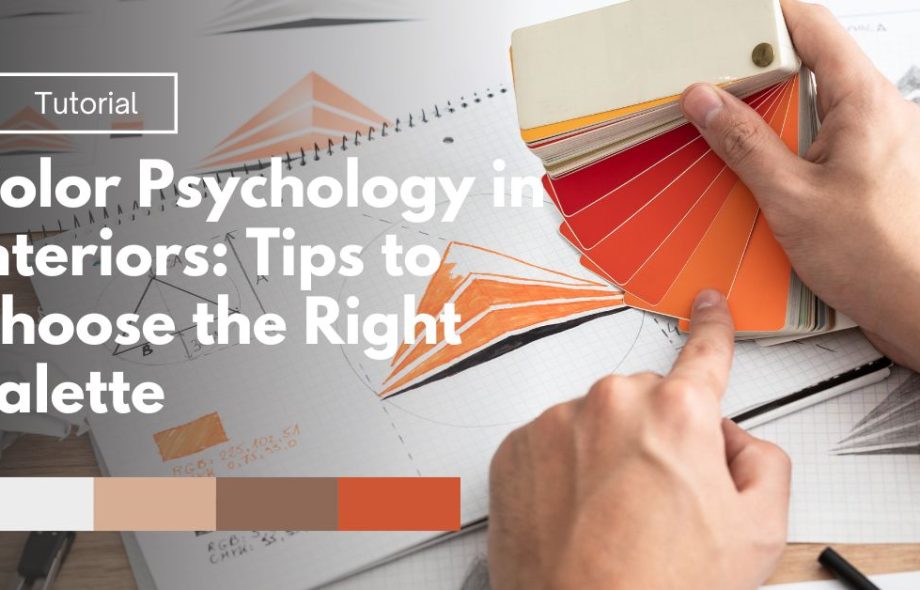Color plays a primary role in interior design. Its influence can significantly shape moods, perspectives, and the conduct of individuals present. Understanding color psychology is necessary for curating spaces that induce the desired emotions.
This blog is your guide to tell you how color impacts our emotions and feelings. We will also cover tips for selecting the best color palette for your home or office.
In addition, if you want to make your interior design more impactful, you need professional help from the best home interior designers in Gurgaon.
Understanding Color Psychology in Interior Design
Color psychology is how multiple colors impact your thoughts, feelings, and emotions. It also impacts your surroundings, which influences your productivity and relaxation. Here are some critical emotions linked to standard colors:
Red: Passion, energy, and action. It can stimulate appetite and increase heart rates.
Blue: Calmness, trust, and serenity. It promotes relaxation and is often used in bedrooms and offices.
Yellow: Happiness and sunshine. This color can stimulate mental activity, but too much can lead to anxiety.
Green: Nature, balance, and restoration. Green is soothing for the eyes and creates a sense of peace & bliss.
Purple: Purple denotes luxury, creativity, and mystery. It is often used to evoke sophistication.
Orange: Enthusiasm and energy. It is inviting and can encourage social interaction.
By understanding these associations, you can tailor your interior design choices to create the desired atmosphere in your space.
How to Assess Your Space Needs?
Before diving headfirst into selecting colors, take a moment to assess your space. Each room serves a different purpose and caters to varying feelings. Here are some questions to ask yourself:
What is the primary function of the room?
Living room (social, relaxed)
Bedroom (rest, calm)
Office (productivity, focus)
What size is the room?
Light colors can make a small space feel larger.
Dark colors can create a cozy feel in larger rooms.
How much natural light does the room receive?
Bright colors can reflect light and brighten dark rooms.
Dark colors are known to absorb light. It creates a more intimate atmosphere.
You must analyze these factors to make more informed color choices.
Tips to Choose the Right Color Palette
With a clear notion of your spatial requirements, your next step involves choosing a color palette. A carefully-picked color palette can enhance the appeal of your interiors. Here’s a systematic approach to this procedure:
1. Start with a Base Color
Your choice of a primary color forms the basis for the subsequent selection. Opt for a neutral shade that suits your taste and supports the room’s purpose. Standard base colors include:
Whites and creams: Timeless, airy, and versatile.
Beige and taupe: Warm and welcoming.
Grays: Modern, chic, and easy to pair with accent colors.
2. Select Accent Colors
Once you’ve chosen your base, add accent colors to introduce visual interest. Select one or two accent colors that complement your base color. For example:
Consider accenting with blush pink and navy blue if you have a soft gray base.
A cream base can look stunning with soft greens and gold accents.
3. Think About Contrast
Do not experiment with contrast.
Introducing varied scales of light and dark can contribute depth to your design.
Employ lighter hues for walls and darker tones for furnishings or fabrics. This contrast creates balance and keeps the space visually dynamic.
4. Create a Cohesive Flow
If your house has a unified layout, ensure continuity in your color preferences from one room to the next.
Nonetheless, this doesn’t imply uniformity in room colors; instead, select harmonizing shades that tie together diverse areas.
It’s generally advised to maintain consistency by incorporating three primary colors across your home.
How to Test Your Color Palette?
Before finalizing your chosen colors, it’s critical to sample them within the space.
Use paint samples: Put color samples on walls to check their appearance at varying daylight times.
View fabrics and textures: Examine how your chosen furniture pieces and decorative elements interact with these shades.
Take your time: Avoid hasty decisions; comfort should be an ultimate factor in your selection.
Final Thoughts
Color psychology may seem straightforward, but selecting the right palette is complex. Professional aid is often required, and acquiring services from proficient home or office interior designers in Gurgaon could be a considered decision.
Click here for a FREE CONSULTATION from an expert interior design company in Gurgaon & Delhi.
Designing your space should be as fulfilling as it is aesthetically pleasing. Happy decorating!












